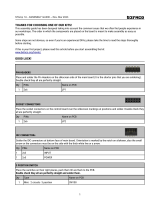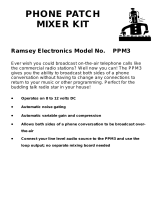Page is loading ...

CHOPPING KINKY V1 - ASSEMBLY GUIDE – Rev. Oct 2022
THANKS FOR CHOOSING ONE OF OUR KITS!
This manual has been written taking into account the common issues that we often find people experience in our
workshops. The order in which the components are placed on the board is meant to make assembly as easy as possible.
Some steps are not obvious, so even if you're an experienced DIYer please read the steps thoroughly before starting. You
will be soldering both boards at the same time.
If this is your first project, please read this article before you start assembling the kit:
www.befaco.org/howto/
ENJOY!
RESISTORS
Color code can be difficult to identify, we strongly recommend to use a multimeter.
Qty
Value
Code
Name on PCB
44
100k
Brown, black, black, orange, brown
R1, R2, R11, R12, R19, R20, R21, R22, R23, R24, R25, R27,
R28, R29, R30, R31, R32, R33, R34, R35, R36, R37, R38,
R40, R41, R42, R48, R101, R106, R108, R111, R115, R118,
R119, R120, R121, R122, R123, R124, R125, R126, R127,
R128, R129
6
1M
Brown, black, black, yellow, brown
R13, R14, R46, R50, R102, R110
4
560R
Green, Blue, black, black, brown
R4, R7, R15, R18
4
1k
Brown, black, black, brown, brown
R45, R49, R51, R130
4
10k
Brown, black, black, red, brown
R39, R43, R105, R107
3
43k
Yellow, orange, black, red, Brown
R17, R116, R117
2
20k
Red, black, black, red, brown
R9, R10
2
30k
Orange, black, black, red, brown
R5, R6
2
47k
Yellow, violet, black, red, brown
R16, R52
2
82K
Grey, red, black, red, brown
R103, R113
2
120k
Brown, red, black, orange, brown
R104, R114
2
200k
Red, black, black, orange, brown
R3, R8
2
300k
Orange, black, black, orange, brown
R44, R47
2
10M
Brown, black, black, green, brown
R100, R131
1
1k8
Brown, gray, black, brown, brown
R112
1
4k7
Yellow, violet, black, brown, brown
R109
1
33k
Orange, orange, black, red, brown
R53
1
150k
Brown, green, black, orange, Brown
R26
1

CHOPPING KINKY V1 - ASSEMBLY GUIDE – Rev. Oct 2022
DIODES
Solder the diodes observing their polarity. The black or white line on the diode (which indicates the cathode – the
negative side) must match with the white line on the diode symbol on the PCB silkscreen.
Qty
Value
Name on PCB
26
1N4148 (orange color)
D1, D2, D3, D4, D5, D6, D7, D8, D9, D10, D11, D12, D13, D14, D15, D16, D17,
D18, D19, D20, D21, D22, D23, D24, D25, D102
2
1N5230B Zener 4.7v
Z1, Z2
2
1N5817 (black color)
D100, D101
FERRITES
Solder the two ferrite beads by using a recycled resistor leg passed through each ferrite and proceed as if it were a
resistor. Ferrite beads don't have polarity.
Qty
Name on PCB
2
F100, F101
ICs
First place the sockets (taking care to orientate them properly – the notch or dot on one end of the IC should match the
image on the silkscreen) and solder them into their correct positions.
Next place the ICs in their respective sockets (again taking note of their orientation – the notch or dot on the top of the
IC must match that of the socket and silkscreen).
Qty
Value
Name on PCB
6
TL072
IC1, IC5, IC6, IC7, IC101, IC102
2
TL074
IC3, IC4
1
LM13700
IC2
1
DG419D
IC8
1
LM393
IC100
2

CHOPPING KINKY V1 - ASSEMBLY GUIDE – Rev. Oct 2022
CAPACITORS
Identifying capacitors can be quite tricky. Codes stated are indicative, please take a look at this guide for help
identifying capacitors: http://www.wikihow.com/Read-a-Capacitor
Qty
Value
Code
Name on PCB
24
100n
104
C1, C2,C102, C103, C3, C4, C5, C6, C7, C8, C9, C10, C11, C12, C16, C17, C18, C19, C104,
C105, C106, C107, C108, C109
1
10n
10nk100
C15
2
10p
10
C13, C14
ELECTROLYTIC CAPACITORS
Values are written on the side of the capacitor. Mind their polarity (The long leg of the capacitor is the positive (+)).
Qty
Value
Code
Name on PCB
2
10uf
10uf
C100, C101
TRANSISTORS
Be sure they are orientated correctly. The curved and flat sides of the silkscreen outline of the transistor on the PCB must
match that of the transistor’s body.
Qty
Code
Name on PCB
2
2N3906
T1, T2
SOCKET CONNECTORS
Place and solder the socket connectors on the control board over the silkscreen markings at positions C_A_3, C_B_3,
C_A_4, C_B_4. Double check they all are perfectly straight.
PIN HEADERS
Place and solder the Pin Headers on the Main Board at C_A_1, C_B_1, C_A_2, C_B_2 where the silkscreen indicates (it is
the shorter pins that you are soldering). Double check they all are perfectly straight.
3

CHOPPING KINKY V1 - ASSEMBLY GUIDE – Rev. Oct 2022
TRIMMERS
Solder the trimmers to the PCB where it is indicated by the silkscreen.
4
103
CAL_A1, CAL_A2, CAL_B1, CAL_B2
POWER CONNECTOR
Solder the power connector at “POWER1”, ensuring it is facing out from the edge of the PCB. The small arrow on the
connectors must be on the side with the thick white line.
Buen trabajo! You’ve already made it quite far through the build. How are your focus
and energy levels? Do you think a 15 minute break would better prepare you for the
rest of the build?
Maybe you could call someone you haven’t talked to in a while or do something
useful like watching videos of cats? Try “harmonizator no cat” on Youtube for
example!
SPACERS
Secure the spacers onto Control PCB (through the holes with silver outlines) with the main body of the spacer on the
component side, and the nut on the opposite.
FRONT PANEL COMPONENTS MOUNTING TIPS:
Now we will proceed to mount the jacks, potentiometer, switches and LEDs. This part of the assembly is
CRITICAL. Please take your time and read the following instructions carefully.
These components must NOT be soldered until they are placed on the PCB and fully attached to the front
panel.
There are two reasons for this:
The height of the panel components are not all the same. Because of this, if not attached properly
before soldering, they will not stay properly seated against the panel. This might cause mechanical
stress reducing their life expectancy and in the worst case cause them to break.
The second reason is that it is very difficult to align the components to the holes if the panel is not
positioned prior to soldering. In the case of the LEDs, they are almost impossible to set to the correct
height without reference to the front panel.
.
4

CHOPPING KINKY V1 - ASSEMBLY GUIDE – Rev. Oct 2022
LEDs
Place the LEDs onto the PCB minding, their polarity, but don't solder them until the front panel is in place. This is the
only way to solder them in the right position.
The long leg is the positive and the short the negative. On the PCB the square pad indicates the negative side and there
is a + symbol to indicate the positive.
Qty
Name on PCB
2
LED_A, LED_B
POTENTIOMETERS
Now place the potentiometer on the PCB. Do not place them all the way down, leave them loose and... don't solder
them yet!
Qty
Type
Name on PCB
4
Single B100k
ATT_A, ATT_B, FOLD_A*, FOLD_B
* FOLD_A POSITIONING LEG MIGHT BE HARD TO SOLDER. IT MIGHT BE EASIEST
TO SOLDER THIS LEG FROM THE FRONT OF THE PCB
MINI-JACKS
Place all the mini-jacks onto the PCB ensuring they are on the silkscreen side, but don't solder yet.
FRONT PANEL
Attach the front panel adjusting the parts one by one if necessary until they fit. At this point a pair of fine tweezers can
be helpful.
To finish:
- Secure the parts to the panel in this order: A) Mini-jacks B)Pot. Take care
to use the correct nuts, as the mini-jack and pot nuts look similar (both black). The mini-
jack nuts are slightly smaller in circumference.
- Ensuring all of the above parts are flush with the panel then you can finally solder them!
- Next, adjust the LEDs so that they are flush with the panel and solder them.
- Connect the main PCB to the control PCB using the pin headers and by threading the M3 screws through the
main PCB and securing them to the spacers. The main PCB should be orientated so that the component side is facing
towards the front panel.
- Put the knobs on the potentiometers.
5

CHOPPING KINKY V1 - ASSEMBLY GUIDE – Rev. Oct 2022
CALIBRATION
We are now going to calibrate the VCA offsets and the internal analog switch to ensure the noise floor
is at a minimum.
A: VCA OFFSET
1) Turn both channels’ waveform level knobs so that they are at zero.
2) Turn both of the attenuverter level knobs to maximum.
3) Generate a square wave at ~1kHz and connect it to channel A’s CV attenuverter input. Channel
A’s CV input is internally connected to Channel B’s so the signal will go to both.
4) Connect the output of Channel A to your monitors.
5) Listen to the output sound and slowly adjust trimmer CAL A1 until you can hear any sound.
6) Connect the output of Channel B to your monitors.
7) Listen to the output sound and adjust CAL B1 until you can hear any sound.
B: ANALOG SWITCH
1) Now take your square wave and connect it to the CHOPP gate input and connect your monitors
to CHOPP OUT
2) Adjust the trimmer at CAL A2 until you can hear any sound.
3) Adjust the trimmer at CAL B2 until you can hear any sound.
4) Repeat steps 2 & 3 until you can hear any sound.
ENJOY YOUR NEW BEFACO MODULE!
6

CHOPPING KINKY V1 - ASSEMBLY GUIDE – Rev. Oct 2022
7

CHOPPING KINKY V1 - ASSEMBLY GUIDE – Rev. Oct 2022
8
/















